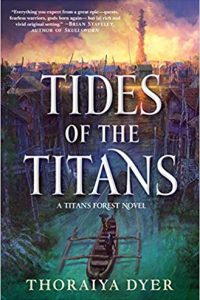Gary K. Wolfe reviews Kit Reed
 If we were to take at face value Tsvetan Todorov’s famously useless definition of the fantastic as existing only during that period of hesitation before a work topples into the truly marvelous or the merely uncanny, then the simple act of identifying a work as SF or fantasy or mimetic realism would constitute a kind of spoiler (in fact, even reviewing it in Locus might). Since Kit Reed’s Son of Destruction is a rare novel that actually makes considerable use of Todorov’s hesitation, the first thing I should tell you about it is that there are things I shouldn’t tell you about it – namely, whether it ends up landing in the uncanny bin or the marvelous bin, or just teeters on that Todorovian pivot all the way through. Reed has certainly chosen a classically uncanny phenomenon as her centerpiece – spontaneous human combustion, which has provided fodder (or should I say kindling?) for writers from Dickens to Gogol to Charles Brockden Brown. She combines this with a couple of far more familiar tropes – the Pandora’s box theme, in which mysteries begin to unfold after opening a box left behind by a dead person, and the small town with an old secret that no one talks about – either of which also could resolve either way.
If we were to take at face value Tsvetan Todorov’s famously useless definition of the fantastic as existing only during that period of hesitation before a work topples into the truly marvelous or the merely uncanny, then the simple act of identifying a work as SF or fantasy or mimetic realism would constitute a kind of spoiler (in fact, even reviewing it in Locus might). Since Kit Reed’s Son of Destruction is a rare novel that actually makes considerable use of Todorov’s hesitation, the first thing I should tell you about it is that there are things I shouldn’t tell you about it – namely, whether it ends up landing in the uncanny bin or the marvelous bin, or just teeters on that Todorovian pivot all the way through. Reed has certainly chosen a classically uncanny phenomenon as her centerpiece – spontaneous human combustion, which has provided fodder (or should I say kindling?) for writers from Dickens to Gogol to Charles Brockden Brown. She combines this with a couple of far more familiar tropes – the Pandora’s box theme, in which mysteries begin to unfold after opening a box left behind by a dead person, and the small town with an old secret that no one talks about – either of which also could resolve either way.
The box in question belongs to Lucy Carteret, who, shortly before dying, tells her son Dan that the ex-marine who brutally raised him – one of Reed’s acidly etched portraits of male catastrophe – isn’t his real dad, but refuses to say who is, or anything else about her earlier life. After her death, Dan, a mostly freelance reporter, finds in her jewelry box clues that set him on a quest for his true identity: a high school football trinket, a couple of photographs, and, oddest of all, a newspaper clipping describing three cases of spontaneous human combustion in the same Florida town over a 50-year period. This is enough to send Dan off to Fort Jude FL, the town in the clipping, which turns out to be an insular, fairly snobbish, and uninviting community where life seems to resolve around high school, church, and the local social club. At first the residents, who you halfway expect to begin stoning outsiders or sacrificing children in the corn, pretend to know nothing of the photographs or of Dan’s mom, but as we shift to the perspective of some of the residents – there are nearly a dozen points of view – we begin to learn of some unspoken catastrophe that occurred decades earlier, during the last few weeks that Lucy lived in Fort Jude, and that may be connected with one of the immolations.
Reed sets up and eventually resolves her mystery with admirable efficiency and skill, though the pace slows a bit as she develops her mosaic portrait of a community largely bound by silence – a high school bully turned middle-aged thug; a hotel owner and her teenage daughter; the Harvard-educated heir of the town’s founder, returned after a failed career at Goldman Sachs; an auto mechanic’s son, spurned as lower class by most of the residents but who earned an MIT scholarship; even the spontaneous combustion victim herself. The real strength of the novel is that precarious balancing act – until almost the end, it could still resolve itself in the direction of either John Cheever or Stephen King, but to say more would be an act of mischievous toppling. Suffice to say that the title character is not at all who you think it is, and that the resolution is both satisfying and more than a little haunting.







